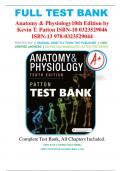FULL TEST BANK
Anatomy & Physiology10th Edition by
Kevin T. Patton ISBN-10 0323529046
ISBN-13 978-0323529044
PRINTED PDF | ORIGINAL DIRECTLY FROM THE PUBLISHER | 100%
VERIFIED ANSWERS | DOWNLOAD IMMEDIATELY AFTER THE ORDER
Complete Test Bank, All Chapters Included.
CHECK OUT MORE FILES HERE:
MEDCONNOISSEURLIBRARIES.COM
,Chapter 01: Organization of the Body
Patton: Anatomy and Physiology, 10th Edition
MULTIPLE CHOICE
1. Which of the following describes anatomy?
a. Using devices to investigate parameters such as heart rate and blood pressure
b. Investigating human structure via dissections and other methods
c. Studying the unusual manner in which an organism responds to painful stimuli
d. Examining the physiology of life
ANS: B DIF: Memorization REF: p. 3
TOP: Anatomy and Physiology
2. Systemic anatomy is a term that refers to:
a. physiological investigation at a microscopic level.
b. anatomical investigation that begins in the head and neck and concludes at the feet.
c. anatomical investigation that uses an approach of studying the body by
systems—groups of organs having a common function.
d. anatomical investigation at the molecular level.
ANS: C DIF: Memorization REF: p. 4
TOP: Anatomy and Physiology
3. Physiology can be subdivided according to the studied.
a. type of organism
b. organizational level
c. systemic function
Aswaretynhstyjuki,ufrikeuj5wq64hy53 t2r4 2t5yq
, d. All of the above are correct.
ANS: D DIF: Memorization REF: p. 4
TOP: Physiology
4. Physiology:
a. recognizes the unchanging (as opposed to the dynamic) nature of things.
b. investigates the body’s structure.
c. is concerned with organisms and does not deal with different levels of organization
such as cells and systems.
d. is the science that examines the function of living organisms and their parts.
ANS: D DIF: Memorization REF: p. 4
TOP: Physiology
5. One of the basic principles of the standardized terminology is the avoidance of , or
terms that are based on a person’s name.
a. homonyms
b. antonyms
c. eponyms
d. synonyms
ANS: C DIF: Memorization REF: p. 5
TOP: Language of Science and Medicine
6. Metabolism refers to:
a. the chemical basis of life.
b. the sum of all the physical and chemical reactions occurring in the body.
c. an organization of similar cells specialized to perform a certain function.
d. a subdivision of physiology.
ANS: B DIF: Application REF: p. 5 TOP: Characteristics of Life
7. From smallest to largest, the levels of organization of the body are:
a. organism, chemical, tissue, cellular, organ, system, organelle.
b. chemical, microscopic, cellular, tissue, organ, system, organism.
c. organism, system, organ, tissue, cellular, organelle, chemical.
d. chemical, organelle, cellular, tissue, organ, system, organism.
ANS: D DIF: Memorization REF: p. 6
TOP: Levels of Organization
8. The smallest living units of structure and function in the body are:
a. molecules.
b. cells.
c. organelles.
d. atoms.
ANS: B DIF: Memorization REF: p. 7
TOP: Levels of Organization
9. An organization of many simN arRcS
ilU elI thG
ls N atTaB
re.sC ciM
peO alized to perform a certain function is
called a(n):
a. tissue.
b. organism.
c. system.
d. organ.
, ANS: A DIF: Memorization REF: p. 7
TOP: Tissue Level
10. An organ is one organizational level lower than a(n):
a. system.
b. cell.
c. organelle.
d. tissue.
ANS: A DIF: Memorization REF: p. 7
TOP: Organ Level
11. The reproductive system includes all of the following except the:
a. testes.
b. ovaries.
c. ureter.
d. penis.
ANS: C DIF: Memorization REF: p. 8
TOP: Body Systems
12. The lungs are located in the:
a. thoracic cavity.
b. mediastinum.
c. abdominal cavity.
d. cranial cavity.
ANS: A DIF: Memorization REF: p. 12
TOP: Body Cavities
13. The mediastinum contains all of the following except the:
a. trachea.
b. venae cavae.
c. right lung.
d. esophagus.
ANS: C DIF: Memorization REF: p. 12
TOP: Body Cavities
14. The gallbladder lies in the:
a. abdominal cavity.
b. pelvic cavity.
c. dorsal cavity.
d. mediastinum.
ANS: A DIF: Memorization REF: p. 13
TOP: Body Cavities




